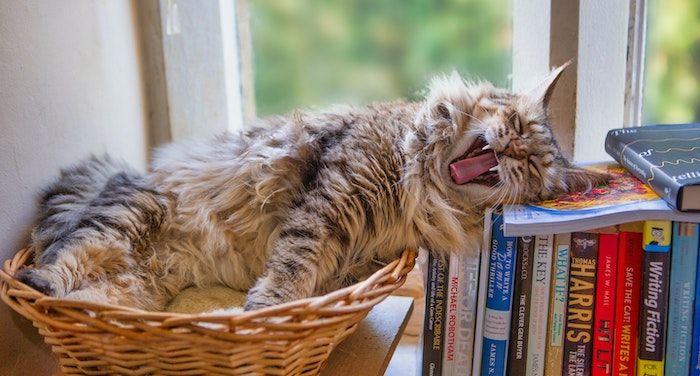
10 Cat Behavior Books To Expertly Adjust Your Feline’s Feistiness
The status of cats as match-made companions for book lovers is well documented. Typical cat behavior is ideally suited for bookish folks: independent, mostly self-sustaining, and quiet. However, for better or for worse, cats experience mood shifts just like us and their habits change in parallel. Maybe your cat’s behavior turns rowdy during your evening reading hour like clockwork. Or, rather than dutifully snoozing next to you, your kitten nibbles at the edge of your paperback.
These behaviors can be cute, but they also take on a different meaning if they disrupt our lifestyle. Whether their rambunctious outbursts interrupt your reading time, sleep schedule, or any other habit, know that there are tons of resources out there to help you understand and try to adjust the behavior of your cat. Since you’re prone to reading books anyway, why not pick up some cat behavior books to better understand your feline friend? And if your furry pal is naturally well-behaved (lucky you), these books can also teach you how to train your cat to perform cool and useful tricks.
A note about this list: The practitioners in the veterinary medicine and animal behavior fields, and particularly the people chosen to publish on these topics, are not very diverse. At the end of this collection of cat behavior books I include a few resources you can use to supplement these materials.
General Cat Behavior Books
1. What Cats Want: An Illustrated Guide for Truly Understanding Your Cat by Yuki Hattori
This guide by a prominent Japanese cat expert is especially useful for visual learners. The sweet illustrations will also support fun learning for children (or adults who are kids at heart) who have just been introduced to a household pet.
2. Decoding Your Cat: The Ultimate Experts Explain Common Cat Behaviors and Reveal How to Prevent or Change Unwanted Ones by the American College of Veterinary Behaviorists
Produced by the American College of Veterinary Behaviorists (the board which certifies practitioners as highly skilled at advancing animal behavior), this in-depth book covers the whole range of cat behaviors. It specifically focuses on helping cat owners to understand cat’s physical and psychological wellness and create an environment to help cats thrive.
3. Think Like a Cat: How to Raise a Well-Adjusted Cat—Not a Sour Puss by Pam Johnson-Bennett
Pam Johnson-Bennett has influenced cat behavior research and consulting for a few decades, so her multitude of publications are an excellent resource. In particular, this book is most useful for learning about establishing training behaviors in the early stages of cat development.
4. The Cat Behavior Answer Book: Practical Insights & Proven Solutions for Your Feline Questions by Arden Moore
This text is an approachable and easily understood guide that explains those quirky cat behaviors and what to do about them. Arden Moore is a bonafide pet-lover and has other useful cat behavior tips on her blog and podcast.
5. Catlady by Leah Reena Goren
Primarily a “love letter to women and their cats,” this beautifully illustrated book includes essays and reflections from women contributors about their personal bond with their feline friends. The author also includes material on how cats have influenced culture throughout the ages (a delightful example: the rise of cat-eye glasses in popular culture). This will appeal to cat owners interested in understanding the power of the human-cat relationship.
6. Catify to Satisfy: Simple Solutions for Creating a Cat-Friendly Home by Jackson Galaxy
Jackson Galaxy is a quirky and high-energy cat behaviorist with a handful of books, an enormous collection of explanatory videos on YouTube, and even a show on Animal Planet called My Cat From Hell. In this book he explains the importance of “catification” (the process of transforming a home into a feline friendly environment) and how to design a space that supports a nurtured and well-behaved cat.
Adult Cat Behavior Books
7. Total Cat Mojo: The Ultimate Guide to Life with Your Cat by Jackson Galaxy
The needs and desires of cats change with their development, so training behaviors used when they are kittens may not garner the same results when they are more advanced in age. In this book Galaxy explains how to encourage confidence (the essence of cat “mojo”) in cats throughout their entire lifecycle.
8. Starting from Scratch: How to Correct Behavior Problems in Your Adult Cat by Pam Johnson-Bennett
This primer offers relief and accessible techniques to owners of adult cats, whether the senior pet is a new addition to the family or a longtime companion who has demonstrated changing behaviors due to aging.
9. Cat Training in 10 Minutes by Miriam Fields-Babineau
Don’t be fooled by the 2003 publication date for this book: its wisdom has withstood the test of time. Miriam Fields-Babineau primarily specializes in dog breeds and training, but adjusts her methods for practical application to cat behavior. Relying on short 10-minute training sessions results in an attentive pet no matter their age.
Behavior Book for Multi-Cat Environments
10. Cat vs. Cat: Keeping Peace When You Have More Than One Cat by Pam Johnson-Bennett
Multi-cat homes are the target of special multi-cat litter formulas, so it makes sense to consider training guides that recognize their unique circumstances. The title of this book defines its purpose clearly, emphasizing tools to minimize tension and encourage harmonious cat-to-cat relationships.
Other noteworthy resources include the work of the late Dr. Sophia Yin, a trained veterinarian and applied animal behaviorist who developed the Low Stress Handling guidelines and certification program. Her book Low Stress Handling Restraint and Behavior Modification of Dogs & Cats: Techniques for Developing Patients Who Love Their Visits is not easy reading since it’s intended for veterinarians, but can help you understand the foundation of animal behavior practice. Finally, the National Association for Black Veterinarians advocates for opportunities for African Americans in veterinary medicine. The group cannot readjust the diversity of veterinary authors overnight, but is doing valuable work to bring along change.
With these handy guides and a strong dose of patience, you are well on your way to forging a lasting bond with a well-behaved cat. If these behavior books pique your interest in other cat-related literature, check out our sources for cat mystery books and children’s books that feature felines.












